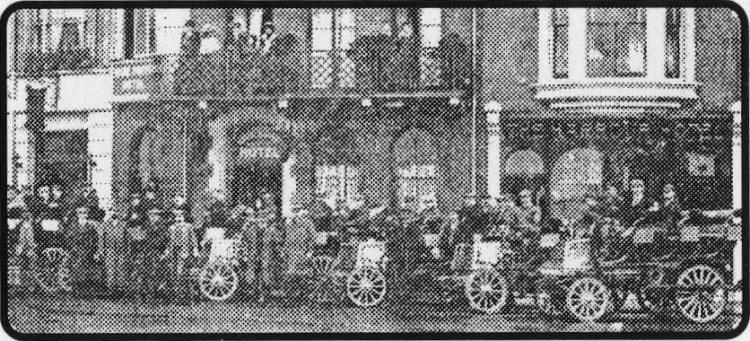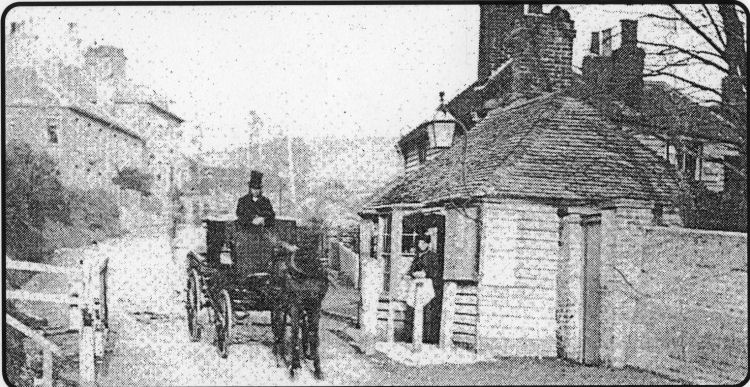
Published 10 August 2000
Wake up...
A VETERAN of the town where she has lived for 75 years, Miss Eileen Martin,
of Hanover House, Folkestone has many happy memories of days gone by. And
she is saddened by many changes that have taken place.
“Our town had character,” she says.
“And to let the town get in the dismal state it is in now is disgraceful,”
she declares.
“The town needs sensible ideas.
“Why were the ferries allowed to go? That was a mistake.
“And why the Tunnel - which many did not want.
“I cannot go out now, but so many people say to me ‘how dreadful the town
has become.’
“But at least I have many lovely memories.
“And thank you for the Memories in the Herald.”
Miss Martin says her family moved into the “dear old pub, the “True Briton,”
on October 26,1926 - “and we had many happy years there.

It was a very bog day when Folkestone's first coach outing of note began
from outside the "True Briton," in 1903.
“The first sign the pub had was of a sailing ship - that aristocrat of the
seas, the East Indiaman ‘True Briton’ of 1790.”
Sadly, she says this sailing
vessel, outward bound on her eighth chartered voyage, having exceeded what
was considered the ‘safe’ total of six, disappeared with all hands.
“I believe she ran into a storm,” says Miss Martin.
The second sign depicted the head and shoulders of an ancient “True Briton”
while the third sign was of the head and shoulders of one of “The Few” - a
True Briton.
Miss Martin says that I mentioned recently Muriel Drury and Beattie
MacDonald, two sisters, and, she says “I spoke to Muriel a couple of years
ago and Beattie has come in to see me several times to chat about the ‘good
old days.’
“The old brewers issued small cards with all their pub signs on, years ago
and I still have the three of the True Briton.
“And Ken and June, who have done a lot to keep the Folkestone local history
from vanishing, asked me if
I would write a few of my memories of the town from 1925, and I wrote a few
words which were printed in a small booklet.
“I remember how we used to rush to see the waxworks, - that was at Gosnolds
- around Christmas time.
“I came to Folkestone in 1925. It was such a lovely little town, lots of
small, privately owned shops, busy harbour, quite a big fishing fleet,
plenty of visitors, Hall Miller’s concert party at the Red Roof Chalet, the
little theatre on the Leas, every summer concert parties at the Marine
Gardens, four cinemas, a big theatre off Sandgate Road, the fete in aid of
the hospital held by the Cheerful Sparrows.
“Then there were the trips on our ferries. A plane trip for 10 shillings and
sixpence (52.5p.) There was the Coop, bottom of Dover Road, and Sainsbury’s
in Sandgate Road and shopping was fun and interesting!”
Thank you Miss Martin for sharing your memories. And to others who have
offered to do the same - let’s hear from you soon too!
Janet Adamson, Heritage Officer at Folkestone Library wonders if any
Memories readers can recall a “Salvage Library” and even perhaps the lady in
charge at 33 Rendezvous Street, a picture of which appeared in the Herald on
August 1, 1942. There was a national appeal for paper for recycling due to a
war shortage of raw materials.
The Herald picture was of two ladies with 3,000 books that were collected -
which shows that those living locally were aware of a serious paper
shortage, says Mrs Adamson.
“Readers may be interested to know we are organising an Open Day at
Folkestone's Grace Hill Library on Saturday, September 16,” she says.
This is part of the national celebrations to mark 150 years of Public
Libraries.
“150 Years of Grace Hill" is the title of a presentation and readings about
the history of
Grace Hill, with a guided walk on Grace Hill with local historian Eamonn
Rooney, on September 16. This is at 3pm and tickets cost £2. It takes in the
Methodist Church, Grace Chapel, Foresters Arms and the cinema.
There are also free “Behind the Scenes" tours of Grace Hill Library at 11am
and 2pm, free book valuations by Tim Parsons, of Elham Bookshop, exhibitions
and Victorian food.
At Sandgate on Sept 16 and 17 the Old Library in the Sandgate Society Rooms
is to open too.

A very early photograph of Sandgate Tollgate I came across recently which
reminds me that historic Tollgate Cottage is being sold by the current
owners - only the second time it has ever been offered for sale. It is
believed to have been built in 1847 replacing an earlier wooden building.
Agents Fell Reynolds say the historic landmark has been used as a film
location twice and 300 postcards of it have been published!
 |
|
1900
Motor taxis all set to take on horse-drawn carriages.
CHRIST Church was celebrating its Golden Jubilee. Motor vehicles were
expected to arrive In town any day to begin competing with horse-drawn
hackney carriages. Eight freehold cottages in Cheriton Street were sold
by auction at the White Lion Inn, Cheriton, for £1,600 by Banks & Son.
Another 10 freehold houses In Denmark Street were sold at the Queen's
Hotel for £3,085. Felix wrote at length for the benefit
of his estimated 10,000 readers, about Hythe horse-bus driver George
Norris who, he said, had handled the 'ribbons" for 16 years and worked
for the owners some time before that, He recalled the day there was only
one bus a day to Hythe, driven by a Mr Mugeam. This later grew to six a
day - and, in 1900 there were 60! He also recalled early buses plying
the route operated by Mr Laker, J Cobay, Mr Scott and Mr Denne. George
Norris remembered when "Corn ripened and cattle fed on the land where
now stand ail those mansions east of the West Cliff Hotel, and there was
only two old black cottages between Seabrook and Hythe - Now look at it.
It's marvellous. No one would have thought such changes could come about
in so short time."
|
|
1925
'Stripping’ bathers in their cars upset local families.
TOP TOMBOLA prize in the Cheerful Sparrows’ fete in aid of the
Royal Victoria Hospital was a two-seater Armstrong-Siddeley car valued
at £360 - quite a sum in 1925. A petition signed by 60 people of
Dymchurch resulted in a parking ban being Imposed on cars on the sea
wall at Dymchurch. It was considered dangerous and the chief complaint,
one suspects was about what was described as ‘indecency' as whole
families undressed in their cars or under umbrellas in order to bathe in
the sea - in full view of residents' windows. As a result of the ban
several large fields were put at the disposal of car and charabanc
owners. New traffic arrangements in Hythe were seriously damaging to
trade complained local traders who were trying to get Hythe Town Council
to reconsider its decision to divert buses away from the busy shopping
area of High Street. The traders pointed out they had spend considerably
on advertising the town to attract visitors and also observed that there
had been no serious accidents in High Street to justify the move.
Bringing visitors into town via back streets did: not create a good
impression. They suggested buses from the Folkestone direction should be
allowed to enter the High Street but leave via Rampart Road. But the
council refused to change its traffic scheme.
|
|
1950
£380,000 coast defence all set to get under way.
FOLKESTONE Town Council gave consent for spending £32,500 on the
first part of the Sandgate Sea Defence scheme estimated to cost
£380,000. The scheme was drawn up by Sir William Halcrow & Partners and
the first step was to build a series of groynes along the beach and to
sink a series of trial pits to assess the state of the existing seawall
before starting extensive repairs. The Town Clerk and Deputy Borough
Engineer reported that emergency repairs had been carried out recently
to protect Beach Court, Sandgate, which had been in imminent danger from
the sea. 90 crews were due to take part in the Folkestone Regatta and
another attraction due to be held was the annual Venetian Fete, at
Hythe, floats having three themes, floral tableaux, humour and Kentish
history and/or a theme of the entrant's choice. On the Marsh "Miss
Australia" (Miss Margaret Hughes) crowned Miss Romney (Miss Peggy
Laurence) at another popular event, the annual Romney Revels. Among
those attending was Miss Kent, Miss Joy Grubb who was last year's Miss
Romney. Teacher at Dover Road School for nearly 30 years Mr C.G. Blunt
received a farewell presentation on his retirement after 41 years
teaching, at the end of the summer term.
|
|
1975
British Rail talks of £12 m bill for Warren rail track.
BRITISH Rail claimed it would be cheaper to re-route
the entire Folkestone to Dover railway line than to spend the estimated
£12 million needed to make the Warren area safe from earth movement and
erosion. It was already spending £850,000 on strengthening the concrete
apron built to hold the cliffs back. Every space in the church was
filled and extra chairs were brought in when young people of St Eanswythe, Folkestone, Hawkinge and Acrise were confirmed Into the
Church of England at a service at St Michael's Church, Hawkinge, by the
Bishop of Dover, the Rt Revd Anthony Tremlett. High powered fund raising
by Dungeness 'B' Power Station generated enough cash flow towards a
project that enabled 240 youngsters of the troublespots of Belfast and
Londonderry to visit Folkestone for a 10-day, tension-free holiday -
with a little bit of help. An appeal went out for local people to
accommodate the 240 youngsters during their stay. Lydd staged a highly
successful local history exhibition in the Guildhall opened by former
mayor Mr GT Paine with a wealth of old photographs, documents, costumes,
tools and implements and even smuggling 'accessories.' The event was
organised by the Friends of Lydd, formed in 1973. Folkestone's eighth
International Folklore Festival got off to a bad start, bad weather
preventing a hot-air balloon launch but nine countries took part.
|
|



